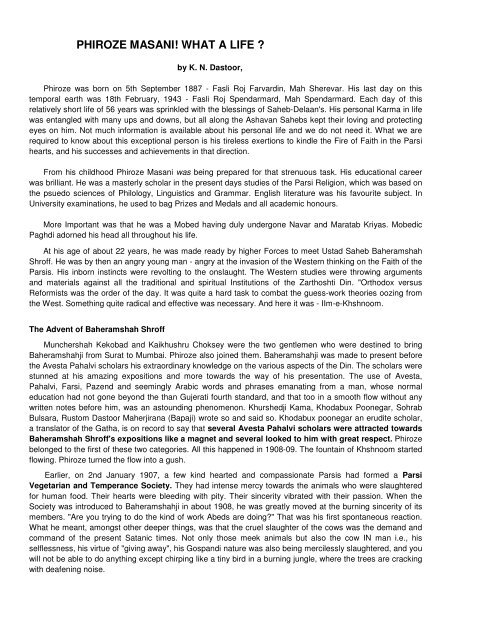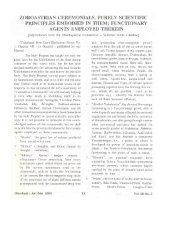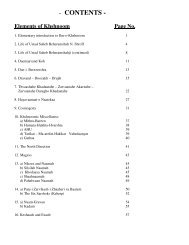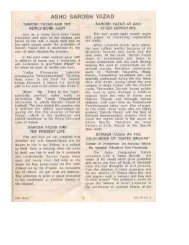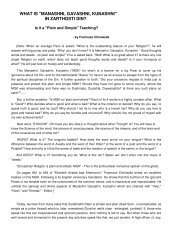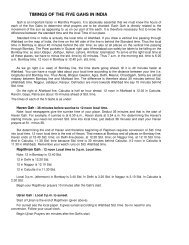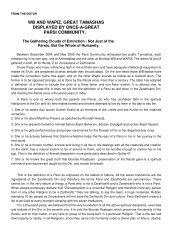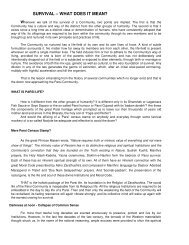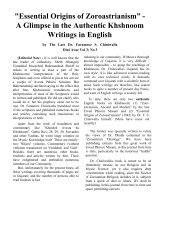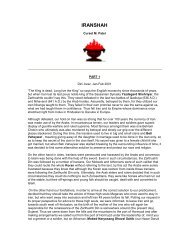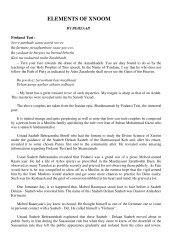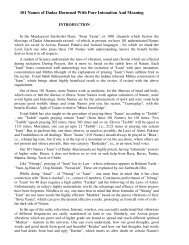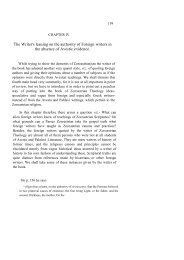phiroze masani! what a life - Traditional Zoroastrianism: Tenets of ...
phiroze masani! what a life - Traditional Zoroastrianism: Tenets of ...
phiroze masani! what a life - Traditional Zoroastrianism: Tenets of ...
Create successful ePaper yourself
Turn your PDF publications into a flip-book with our unique Google optimized e-Paper software.
PHIROZE MASANI! WHAT A LIFE ?<br />
by K. N. Dastoor,<br />
Phiroze was born on 5th September 1887 - Fasli Roj Farvardin, Mah Sherevar. His last day on this<br />
temporal earth was 18th February, 1943 - Fasli Roj Spendarmard, Mah Spendarmard. Each day <strong>of</strong> this<br />
relatively short <strong>life</strong> <strong>of</strong> 56 years was sprinkled with the blessings <strong>of</strong> Saheb-Delaan's. His personal Karma in <strong>life</strong><br />
was entangled with many ups and downs, but all along the Ashavan Sahebs kept their loving and protecting<br />
eyes on him. Not much information is available about his personal <strong>life</strong> and we do not need it. What we are<br />
required to know about this exceptional person is his tireless exertions to kindle the Fire <strong>of</strong> Faith in the Parsi<br />
hearts, and his successes and achievements in that direction.<br />
From his childhood Phiroze Masani was being prepared for that strenuous task. His educational career<br />
was brilliant. He was a masterly scholar in the present days studies <strong>of</strong> the Parsi Religion, which was based on<br />
the psuedo sciences <strong>of</strong> Philology, Linguistics and Grammar. English literature was his favourite subject. In<br />
University examinations, he used to bag Prizes and Medals and all academic honours.<br />
More Important was that he was a Mobed having duly undergone Navar and Maratab Kriyas. Mobedic<br />
Paghdi adorned his head all throughout his <strong>life</strong>.<br />
At his age <strong>of</strong> about 22 years, he was made ready by higher Forces to meet Ustad Saheb Baheramshah<br />
Shr<strong>of</strong>f. He was by then an angry young man - angry at the invasion <strong>of</strong> the Western thinking on the Faith <strong>of</strong> the<br />
Parsis. His inborn instincts were revolting to the onslaught. The Western studies were throwing arguments<br />
and materials against all the traditional and spiritual Institutions <strong>of</strong> the Zarthoshti Din. "Orthodox versus<br />
Reformists was the order <strong>of</strong> the day. It was quite a hard task to combat the guess-work theories oozing from<br />
the West. Something quite radical and effective was necessary. And here it was - IIm-e-Khshnoom.<br />
The Advent <strong>of</strong> Baheramshah Shr<strong>of</strong>f<br />
Munchershah Kekobad and Kaikhushru Choksey were the two gentlemen who were destined to bring<br />
Baheramshahji from Surat to Mumbai. Phiroze also joined them. Baheramshahji was made to present before<br />
the Avesta Pahalvi scholars his extraordinary knowledge on the various aspects <strong>of</strong> the Din. The scholars were<br />
stunned at his amazing expositions and more towards the way <strong>of</strong> his presentation. The use <strong>of</strong> Avesta,<br />
Pahalvi, Farsi, Pazend and seemingly Arabic words and phrases emanating from a man, whose normal<br />
education had not gone beyond the than Gujerati fourth standard, and that too in a smooth flow without any<br />
written notes before him, was an astounding phenomenon. Khurshedji Kama, Khodabux Poonegar, Sohrab<br />
Bulsara, Rustom Dastoor Maherjirana (Bapaji) wrote so and said so. Khodabux poonegar an erudite scholar,<br />
a translator <strong>of</strong> the Gatha, is on record to say that several Avesta Pahalvi scholars were attracted towards<br />
Baheramshah Shr<strong>of</strong>f's expositions like a magnet and several looked to him with great respect. Phiroze<br />
belonged to the first <strong>of</strong> these two categories. All this happened in 1908-09. The fountain <strong>of</strong> Khshnoom started<br />
flowing. Phiroze turned the flow into a gush.<br />
Earlier, on 2nd January 1907, a few kind hearted and compassionate Parsis had formed a Parsi<br />
Vegetarian and Temperance Society. They had intense mercy towards the animals who were slaughtered<br />
for human food. Their hearts were bleeding with pity. Their sincerity vibrated with their passion. When the<br />
Society was introduced to Baheramshahji in about 1908, he was greatly moved at the burning sincerity <strong>of</strong> its<br />
members. "Are you trying to do the kind <strong>of</strong> work Abeds are doing?" That was his first spontaneous reaction.<br />
What he meant, amongst other deeper things, was that the cruel slaughter <strong>of</strong> the cows was the demand and<br />
command <strong>of</strong> the present Satanic times. Not only those meek animals but also the cow IN man i.e., his<br />
selflessness, his virtue <strong>of</strong> "giving away", his Gospandi nature was also being mercilessly slaughtered, and you<br />
will not be able to do anything except chirping like a tiny bird in a burning jungle, where the trees are cracking<br />
with deafening noise.
Two decades thereafter, on 2nd January, 1932 at the silver jubilee function <strong>of</strong> the Society, Dr. Saheb<br />
Framroze Chiniwalla referred to Ustad Saheb's above words and compared the situation with the famous<br />
Farsi mystic poet Khwaja Shamsuddin Hafez <strong>of</strong> Shiraz's agony towards the miseries <strong>of</strong> the humans. He<br />
has expressed his intense compassion in the first 5 couplets <strong>of</strong> his Diwan-e-Hafez. Dr. Saheb's presidential<br />
address at the function is set out in Frashogard Vol. 21 No.1 to 4 - July 1931 to June 1932. He presented the<br />
inherent explanation <strong>of</strong> Hafez's couplets, based on Ustaad Saheb's interpretation which no other translator<br />
has dreamt <strong>of</strong>. Hafez said he was dying with the extreme distress his heart was undergoing, when the<br />
miseries and sufferings <strong>of</strong> the humans were passing before his eyes.<br />
FRASHOGARD<br />
Baheramshahji then allowed the Society to propagate the Khshnoomic Doctrines and Truths from its<br />
stage. The Khshnoom movement now gathered momentum. Phiroze was now fully engrossed in his mission.<br />
The time was ripe for an organ <strong>of</strong> Khshnoom, a periodical which would accelerate the flow <strong>of</strong> Khshnoom.<br />
Parsi Vegetarian and Temperance Society was toying with the idea <strong>of</strong> such a magazine. Even before the<br />
advent <strong>of</strong> Baheramshahji, Phiroze had in his mind the name "Frashogard" for it. When Baheramshahji was<br />
told about the proposed magazine and its name, he approved both. He was very pleased at the name<br />
Frashogard. He explained (within the framework <strong>of</strong> his permission) <strong>what</strong> Frashogard means. From the 5th<br />
Vol, <strong>of</strong> the magazine (1915), it carried a specially made picture on its first cover page. The same issue<br />
contained a special article directly written by Ustad Saheb himself under the heading "Frashogard ni Taavil",<br />
in which he explained the technical (Ilmiati) aspects <strong>of</strong> the phenomena <strong>of</strong> Frashogard in nature and its stages.<br />
(Please see page 13)<br />
PHIROZE, THE BLESSED<br />
* * * * *<br />
The fact that Phiroze and his mission was blessed by the Saheb-Delaans was confirmed by a dream<br />
Munchershah Master had. He Saw a Mehfil <strong>of</strong> Zarthoshti Aabeds sitting with great grace and dignity, and a<br />
short statured Mobed was seen running from one place to another. Manchershah instantly felt that the Mobed<br />
was Phiroze. The late Jehangir Chiniwalla had told this in his class lecture at Mithaiwalla Dar-e-Meher, when<br />
this writer was present.<br />
* * * * *<br />
PHIROZE, THE ANGRY YOUNG MOBED.<br />
My uncle Bapaji who was a disciple <strong>of</strong> Baheramshahji and a University Pr<strong>of</strong>essor, and my father Ervad<br />
Navroz bin Dinshah who was a Pav Mahel Mobed <strong>of</strong> rare qualities and virtues had told me about an event in<br />
Phiroze's <strong>life</strong>. Somewhere in the first decade <strong>of</strong> the 20th Century (1910 perhaps) there was a Conference <strong>of</strong><br />
some pompous scholars and their lay-satelites who called themselves "reformists". The aim was to tell Parsis<br />
to discard all their spiritual and traditional Institutions. Why? Because the modern European scholars <strong>of</strong> our<br />
Religion have found that all those were the craftiness and conspiracy <strong>of</strong> later priests and that the Gatha was<br />
the only "true" "<strong>Zoroastrianism</strong>". One <strong>of</strong> the speakers said that it was not necessary to recite Sanskrit<br />
Aashirvad in our marriage ceremony because it was just a word given to Jadirana by the then refugee Parsis.<br />
A young Mobed with angry eyes in the audience jumped up and shouted,<br />
"Would that not be the sin <strong>of</strong> Meher-daruji? A breach <strong>of</strong> a solemn promise?" That was Phiroze!<br />
Age around 23 years!<br />
There was a sensation in the audience. That one question was sufficient to expose the naked futility <strong>of</strong><br />
not only that reformist conference but the whole <strong>of</strong> the so called reformist movement. Phiroze's question can<br />
well be transmuted thus: Does it not mean that all your exercise on reformism is based on immortalities like<br />
breach <strong>of</strong> promise? The speaker was stunned. His tongue was stuck to the palate. A learned Dastoorji (I am<br />
not sure, but he was probably from the erudite Sanjana family) rushed to Phiroze to pat his back: "Shabaash,
Shabaash"!<br />
My teacher Dosabhai Desai used to tell me that Phiroze's face <strong>of</strong>ten looked like the face <strong>of</strong> an angry<br />
young Mobed, who would care a dime for any Akbarshah or Bajirao, when Din was concerned. A born<br />
Valiant-for-Truth!<br />
* * * * *<br />
"ZOROASTRIANISM, ANCIENT AND MODERN"<br />
There was one well known (the late) Dastoorji Dhalla <strong>of</strong> Karachi, who began as orthodox and ended as<br />
"reformist". (May his Ruvaan proceed further and further towards Frashogard!) He wrote a pompous book<br />
"Zoroastrian Theology" published by Columbia University. It became the Satan's Bible for the so termed<br />
"reformists." The book was haunted with two obsessions: One was the Gatha-alone cultism and the other was<br />
the alleged command <strong>of</strong> Zoroastrian Religion to convert others even by force if required.<br />
Dr. Dhalla's book came to the then Trustees <strong>of</strong> Mumbai Parsi Punchayet for patronage and support.<br />
Justice Dinshah Davar was one <strong>of</strong> the Trustees. He convinced the other Trustees not to patronise the Book.<br />
The then reformist Press launched a dirty attack on Justice Davar. It was Phiroze's Khshnoomic colleague<br />
Ervad Sohrab Panthaky who suggested to Phiroze to write a book in reply to Dr. Dhalla's mishmash. "Please<br />
do it for Justice Davar's sake" he told Phiroze. Phiroze contacted Justice Davar. He was highly impressed by<br />
Phiroze's knowledge and zeal. He promised all encouragement and help. Unfortunately he died before<br />
Phiroze could complete the Book. But it was finished and published in 1917, with the financial help by one<br />
Framroze Kavarana, in the name <strong>of</strong> his son Kaikhushru, a brilliant scientist, who had died young.<br />
The name <strong>of</strong> the book was "<strong>Zoroastrianism</strong>, Ancient and Modern." It is primarily intended to refute Dr.<br />
Dhalla's immature arguments. But the book can be well considered as a primary text book <strong>of</strong> IIm-e-<br />
Khshnoom. Dr. Dhalla's propositions are controverted on the grounds <strong>of</strong> the Western philology and the<br />
Truths revealed by Khshnoom. Phiroze says in the prologue that philological studies "merely procures the<br />
shells….. whereas Khshnoom inserts the original kernel necessary to make the whole nut." Khshnoom can<br />
help and embellish the philological study <strong>of</strong> Avesta, he wrote. His book is the sure pro<strong>of</strong> <strong>of</strong> this. For instance,<br />
while refuting the babies <strong>of</strong> Dr. Dhalla on Manthra Prayers, he has given, on the word "Stota", 13 references<br />
from the Gatha, 13 from the 'Yashta's, 7 from Yazashney, 5 from Visperad, 1 from Hadokhta Nask, and 1<br />
from Avan Niyaish. (Total 40). On "Manthra", there are 12 references from the 'Gatha's', 15 from Yazashney,<br />
10 from Visparad 29 from Yashta's, 4 from other Avesta (in all 70.) Phiroze's translations adopt the usual<br />
methodology <strong>of</strong> the Western philology, but inject therein the Khshnoomic meanings and explanations. This<br />
converts the philological copper into spiritual gold, which can take any honest objective, truth loving person in<br />
devotional ecstasy.<br />
The Book has been reprinted in 2000 AD and is available at Parsi Vegetarian and Temperance Society<br />
Vatsa Bldg. Janmabhoomi Marg, Fort, Mumbai.<br />
WORK ON THE PAZEND PRAYERS<br />
Phiroze was a scholar par excellence in the Western methods <strong>of</strong> the study <strong>of</strong> Avesta, Pahalvi, Pazend<br />
and Oriental languages. He has translated all Pazend 'Aafrin's and 'Setaayash's. Bapuji told us that<br />
Baheramgor Anklesaria, a formidable scholar and critic was all praises for Phiroze's monumental work on<br />
Pazend Prayers.<br />
PHIROZE'S HELP TO KAVASJI KANGA'S TRANSLATIONS<br />
A particular illogicity exists in our Community. On the one hand there is a Gatha alone cult (now baptised<br />
as GAC), which says Gatha alone is the Zoroastrian Religion. On the other hand, there are dozens <strong>of</strong> varied<br />
and variant translations from various scholars and as Mary Boyce, the favourite Scholar <strong>of</strong> the orthodox clan<br />
herself has pointed out, there is wide diversity <strong>of</strong> opinion as to <strong>what</strong> the Prophet originally taught in the Gatha.<br />
The recent translator Insler enumerated several heavy difficulties a translator <strong>of</strong> Gathas comes across. It is "a
ook <strong>of</strong> Seven Seals," he wrote. The million dollar question arises: how can you say Gatha alone is the<br />
Prophet's religion when there is a mountain <strong>of</strong> uncertainties in their dozens <strong>of</strong> Westernised translations? We<br />
have the Gujerati translation <strong>of</strong> Kavasji Kanga in which we find the tremendous amount <strong>of</strong> doubts and<br />
obstacles he faced. He had the humility to express his inability to translate about 10 passages. They were<br />
Haa 31-2, 32-7, 32-14, 33-9, 46-5, 46-9, 50-3, 51-14, 51-16. While publishing the 4th edition in 1934, Kavasji<br />
Kanga's grandson Navroji Pestonji Kavasji Kanga requested Phiroze to translate those passages, which he<br />
did. 4th Edition thus has Phiroze's translations <strong>of</strong> those passages at the end. A serious student <strong>of</strong> the Gathas<br />
will see from Phiroze's translations how the Khshnoomic meanings bring out the spiritual and esoteric<br />
message and essence <strong>of</strong> the Gathas. "Only they shall see who has eyes to see."<br />
Similarly, at the request <strong>of</strong> Kavasji's grandson in the 10th Edition <strong>of</strong> Kavasji's translation <strong>of</strong> Khordeh<br />
Avesta (1926), Phiroze's translations <strong>of</strong> "Yaa too ji Zarathushtra..." passage <strong>of</strong> Haptan Yashta and para 59 <strong>of</strong><br />
Kardeh 19 <strong>of</strong> Baheram Yasht are appended. The edition also contains Phiroze's translation <strong>of</strong> Pazend<br />
Aashirvaad forming part <strong>of</strong> the Manthra blessings recited at the Parsi Marriage ceremony.<br />
* * * * *<br />
But the best work <strong>of</strong> Phiroze is his Frashogard Journal 1911-1943. Please see page 11.<br />
FAREWELL! PHIROZE!<br />
Phiroze died on 18-2-1943. The issue <strong>of</strong> July-December 1942 (published after February 1943) carried the<br />
news on an attached slip; the issue carried Phiroze's 40th article in the series: "Remedies for the upliftment <strong>of</strong><br />
the Parsi Community". The subject was about Kriyakaam particularly the ceremonies for the departed…. And<br />
that was the last….. Who knew he himself would depart?<br />
Minoo Patel laments on page 28.<br />
Nanabhoy Mama pays a glowing tribute on page 27.<br />
Those who knew Phiroze and his Himalayan task wept in silence. Some were too stunned to believe.<br />
Their heart cried like Rumi's towards his Guide Shams-e-Tabreez.<br />
Dh Dh Dh xksQr xksQr ds ds vku vku >sUn;s >sUn;s îohn îohn cseksnZ cseksnZ? cseksnZ<br />
Dh Dh Dh xksQr xksQr ds ds vkQrkcs vkQrkcs mehn mehn cseksnZ cseksnZ? cseksnZ<br />
Dks.ks Dks.ks dáqa dáqa ds ds rs rs îosnku îosnku îosnku Ôoukjks Ôoukjks ejh ejh ejh x;ks x;ks? x;ks<br />
Dks.ks Dks.ks Dks.ks dáqa dáqa ds ds rs rs mehnuks mehnuks vkQrkc vkQrkc ejh ejh x;ks x;ks? x;ks<br />
vus 'Els rczh> ekVs #eh xk; Ns :<br />
Ykcgk;s Ykcgk;s Ykcgk;s o; o; vkuxkg vkuxkg vkuxkg ds ds ch ch bLrh> bLrh> cqn<br />
cqn<br />
nj nj gj gj nks nks tsgku tsgku v> v> m m 'dj 'dj jh> jh> cqn<br />
cqn<br />
Xkj Xkj Xkj nj nj nj nsys nsys nsys rUxs rUxs rUxs [kqn [kqn [kqn rq rq ekgh ekgh ekgh chuh chuh<br />
chuh<br />
v> v> v> eu eu eu cs'kuo cs'kuo ds ds ds 'kEls 'kEls 'kEls rczh> rczh> cqn<br />
cqn<br />
í;kjs í;kjs vsuk vsuk gksBks gksBks xqLlkFkh xqLlkFkh Hkjkb Hkjkb trk<br />
trk<br />
R;kjs R;kjs cUus cUus tsgkueka tsgkueka rsekaFkh rsekaFkh lkdj lkdj ojlrh<br />
ojlrh<br />
îs rkjka rkjka [kq [kqnuka [kq nuka rUx rUx nsyeka nsyeka rqa rqa rqa ekg ekg us us tqvs<br />
tqvs<br />
Rks Rks ekjkFkh ekjkFkh ekjkFkh let let let ds ds rs rs 'Els 'Els rczh> rczh> grks grks. grks<br />
vk lrjuh pksFkh yhVh ekSykuk #ehuh ekQh<br />
Ekaxhus lgst cnyqa Nqa ds :<br />
“v> v> eu eu cs'kuo cs'kuo cs'kuo ds ds ekgs ekgs Qh#> Qh#> cqn cqn.” cqn cqn<br />
vsuk vsuk xqLlk xqLlk Hkjsyk Hkjsyk gksBekaFkh gksBekaFkh rks rks cUus cUus tsgkueka<br />
tsgkueka<br />
Lkdjuks Lkdjuks Lkdjuks ojlkn ojlkn iMrks iMrks grks grks. grks vsuk vsuk xqLlkeka xqLlkeka xqLlkeka i.k i.k<br />
i.k
Nhuuh Nhuuh nk>uh nk>uh ehBk'k ehBk'k grh grh. grh<br />
vk vk vk tsgkuFkh tsgkuFkh tsgkuFkh rUx rUx rUx Fkb Fkb Fkb trka trka trka rkjka rkjka rkjka nhyeka nhyeka nhyeka îs îs<br />
îs<br />
Dksb Dksb o[kr o[kr pkan pkan pkan ns[kk; ns[kk;, ns[kk;<br />
Rks Rks gqa gqa dgqa dgqa Nqa Nqa rs rs let let ds ds vs vs rks rks ekgs ekgs Qh#> Qh#> grks grks, grks<br />
Rks Rks Rks ekg ekg grks grks tsuqa tsuqa uke uke Qhjks> Qhjks> grqa grqa. grqa<br />
* * * * *<br />
nsy rUx uk dj, nsyuks [kksyukj vkoh x;ks Ns.<br />
byeuk Loj ybus {uweuks flrkj vkoh x;ks Ns.<br />
Rkjk 'kdks xqekuus ek[khuh tse dpMh uk[k'ks<br />
Ds dqgs dkQekaFkh gqekuks fpRdkj vkoh x;ks Ns.<br />
vjs vk 'kqa? vekjka vklqekaFkh i.k gkL; Vids?<br />
Ds dqgs nsekoanFkh dsdkus glkoukj vkoh x;ks Ns.<br />
* * * * *<br />
CONTRIDICTIONS GALORE OF DR. DHALLA<br />
In his "<strong>Zoroastrianism</strong>, Ancient and Modern" Phiroze Masani has a given on pages xxx to xxxiii, "A collection <strong>of</strong><br />
Dr. Dhalla's 45 inconsistencies," contained in his Book "Zoroastrian Theology." Dr. Dhalla was a man <strong>of</strong> confused<br />
thinking. His writings and speeches suffered from an indigestion <strong>of</strong> traditional orthodoxy and the 19th century Western<br />
thinking. He advocated Gatha-Alone-Cult and branded Yazats as "pre-Zoroastrian divinities" to be discarded, and yet he<br />
himself venerated the Yazats like his forefathers (p. 77-78 <strong>of</strong> his Book.) Mary Boyce has referred to this and other<br />
contradictions with which, as she says, he "was able to live." (Page 213 - "Zoroastrians, Their Religious Beliefs and<br />
Practices" - Mary Boyce - Routledge and Kegan Paul (1979 - 1985-6-7). He blasphemed the Rituals all his <strong>life</strong>, but when<br />
his good wife died, he got all the traditional Religious ceremonies performed. (Dr. Hormuzshah Vania <strong>of</strong> Karachi testified<br />
to this.) He purported to base his thinking on Darwinian theory which was the foundation <strong>of</strong> Godlessness in the then<br />
Western thought and even today! (vide Richard Dawkins). In my youth I was quite astounded and amused at this<br />
Darwinian Dastoor!<br />
Phiroze's collection <strong>of</strong> Dr. Dhalla's 45 inconsistencies makes an amusingly interesting reading. Below are Just a few<br />
items from Phiroze's list:<br />
Pahalvi works - useful versus useless; Gathas and younger Avesta - split versus supplement; far removed versus<br />
commentary; 21 Nasks - not given by Zoraster versus Lord God has announced them to the holy prophet; efficacy <strong>of</strong><br />
Zoroastrian rituals none, versus ceremonies longed for by the fravashis <strong>of</strong> the dead; Zoroaster, practical, common sense<br />
thinker Vs disorder in the World demands the services <strong>of</strong> a great Master-mind, a genius, a philosopher nay a prophet, a<br />
YAZATA!<br />
Tell me! These are only 7 out <strong>of</strong> the 45 coloured spectrum <strong>of</strong> Dhalla-ian contradictions.<br />
As Mary Boyce said he could live with them. But does she know the reason? We Parsis have the habit <strong>of</strong> being<br />
carried away by pompous Western degrees. We shower praises not on the merits or contents <strong>of</strong> <strong>what</strong> somebody says or<br />
writes from his head, but on his high sounding University tails. We do not care to read and find out ourselves. By the way<br />
the Jafrey-Irani(s) - GAC are self declared Dhalla-ites.<br />
- K.N.D.<br />
(Parsi Pukar Jul.-Aug.-Sep. 2003 - Vol. 9; No. 1)


